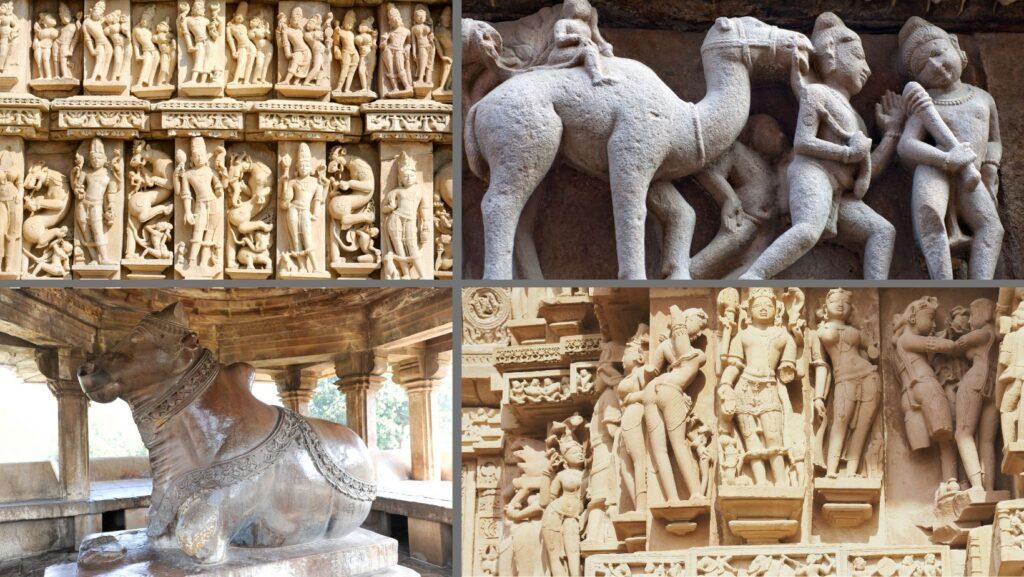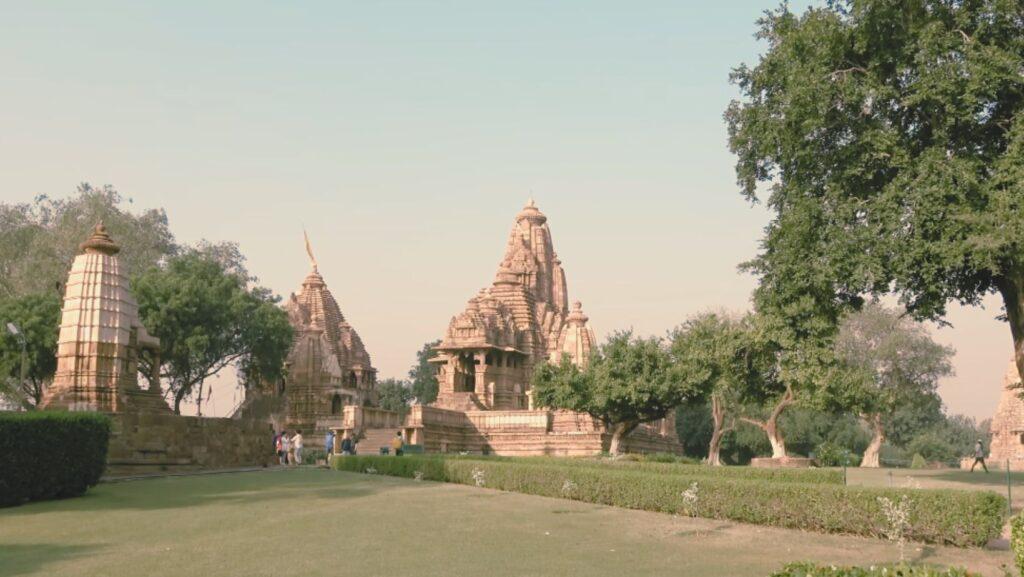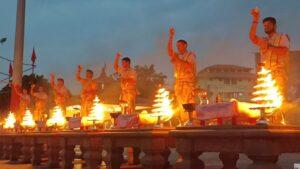About Khajuraho Temple
Khajuraho Temples, Madhya Pradesh, are a group of Hindu and Jain temples that showcase the artistic and architectural excellence of the Chandela dynasty that ruled the region from the 10th to the 11th century CE. The temples are located in a picturesque landscape, surrounded by rivers, forests, and hills.
The temples are famous for their intricate and elaborate carvings that depict various themes, such as mythology, spirituality, romance, and daily life. The temples are also known for their erotic sculptures that represent the celebration of love and life.
The Khajuraho Temples are divided into three clusters: the Western, the Eastern, and the Southern. The western cluster is the largest and most prominent one, containing some of the most famous temples, such as the Kandariya Mahadeva Temple, the Lakshmana Temple, the Devi Jagadambi Temple, and the Chitragupta Temple.
The eastern cluster contains mainly Jain temples, such as the Parsvanatha Temple, the Adinatha Temple, and the Shantinatha Temple. The southern cluster contains a few temples, such as the Duladeo Temple and the Chaturbhuj Temple.
Khajuraho Temples: Mythology
- The mythology behind the Khajuraho temples is based on various legends and stories that explain the origin and significance of these monuments.
- One of the most popular myths is that of Hemvati, a beautiful woman who was the daughter of a Brahmin priest. In this myth, Hemvati was bathing in a pool near Benaras, when she caught the eye of the Moon God, who was enchanted by her beauty. He descended from the sky and seduced her, resulting in her pregnancy.
- She bore a son named Chandravarman, preordained to establish the Chandela dynasty’s roots.
- Another myth is that of Khajuraho, the name of the place where the temples are located. According to this myth, Khajuraho was derived from the word “khajura”, which means “date palm”. The legend says that there was once a golden date palm tree in Khajuraho, which was worshipped by the locals as a symbol of fertility and prosperity. The tree was also said to be the abode of a divine couple, who blessed the people with happiness and harmony.
- A third myth is that of Parvati, the consort of Lord Shiva, who is one of the main deities worshipped in the Khajuraho temples. According to this myth, Parvati once performed a severe penance in Khajuraho, to please Shiva and win his love. She stood on one leg for a thousand years, enduring all kinds of hardships and temptations. Shiva was impressed by her devotion and appeared before her, asking her to marry him. Parvati agreed, and they got married in Khajuraho, in a grand ceremony attended by all the gods and goddesses.
- A third myth is that of Parvati, the consort of Lord Shiva, who is one of the main deities worshipped in the Khajuraho temples. To this myth, Parvati once performed a severe penance in Khajuraho, to please Shiva and win his love. She stood on one leg for a thousand years, enduring all kinds of hardships and temptations. Shiva was impressed by her devotion and appeared before her, asking her to marry him. Parvati agreed, and they got married in Khajuraho, in a grand ceremony attended by all the gods and goddesses.
Khajuraho Temples Architecture
- The architecture of the Khajuraho temples is based on the Nagara style, which is characterized by a distinct type of tower or shikhara above the sanctum.
- The shikhara is composed of several layers of smaller spires, called urushringas, that create a vertical thrust and symbolize Mount Kailasa, the abode of the gods. The shikhara is crowned by a large circular stone disc, called amalaka, which supports a pot-shaped finial, called kalasha.
- The Khajuraho temples are made of sandstone blocks that are fitted together without any mortar or cement. The stones are carved with intricate patterns and motifs that cover all surfaces of the temples.
- The carvings depict various themes, such as gods and goddesses, celestial beings, mythical creatures, animals, plants, geometric designs, and human figures.
- The human figures are shown in various poses and expressions, such as dancing, playing music, fighting, teaching, meditating, and making love. The erotic sculptures are not meant to be obscene or vulgar, but rather to illustrate the concept of kama or desire, which is one of the four goals of human life in Hinduism.
Khajuraho Temples Sculptures

- The sculptures of the Khajuraho temples are made of sandstone blocks that are fitted together without any mortar or cement.
- The stones are carved with exquisite patterns and motifs that cover all surfaces of the temples. The sculptures depict various forms of life, such as gods and goddesses, celestial beings, mythical creatures, animals, plants, geometric designs, and human figures.
- The erotic sculptures of the Khajuraho temples are not meant to be obscene or vulgar, but rather to illustrate the concept of kama or desire, which is one of the four goals of human life in Hinduism.
- The sculptures also reflect the social and cultural life of the Chandela period, as well as their artistic and aesthetic sensibilities. The erotic sculptures are found mainly on the outer walls of the temples, while the inner walls are reserved for more sacred themes.
Khajuraho Temples Entry Fee, Timing
- The entry fee for Indian tourists is Rs. 30 per person, while for foreign tourists it is Rs. 550 per person.
- The entry fee for the camera is Rs. 200 and for video camera is Rs. 2000.
- The opening and closing time of the Khajuraho temples is from sunrise to sunset. Monuments remain open on all days.
- The museum opening hours are from 9:00 am to 5:00 pm.
- The best time to visit the Khajuraho temples is from October to March, when the weather is pleasant and the wildlife is more active.
Is Khajuraho temple Hindu or Jain?
The Khajuraho group of temples were built together but were dedicated to two religions, Hinduism and Jainism, suggesting a tradition of acceptance and respect for diverse religious views among Hindus and Jains in the region.
Which is the oldest temple in Khajuraho?
The Chausath Yogini temple is a ruined Yogini temple in the Khajuraho town of Madhya Pradesh, India. Dated to the late 9th century, it is the oldest surviving temple at Khajuraho.







